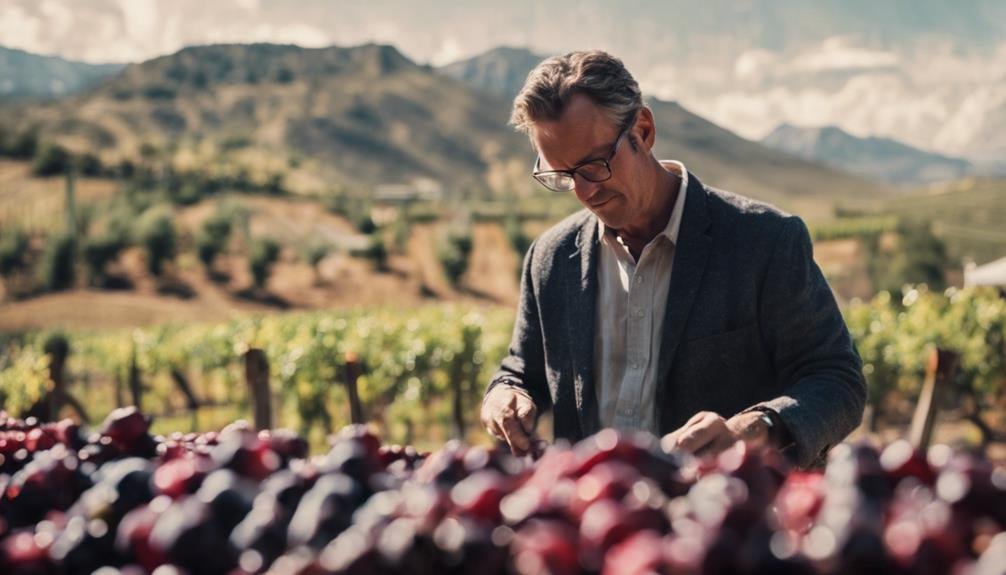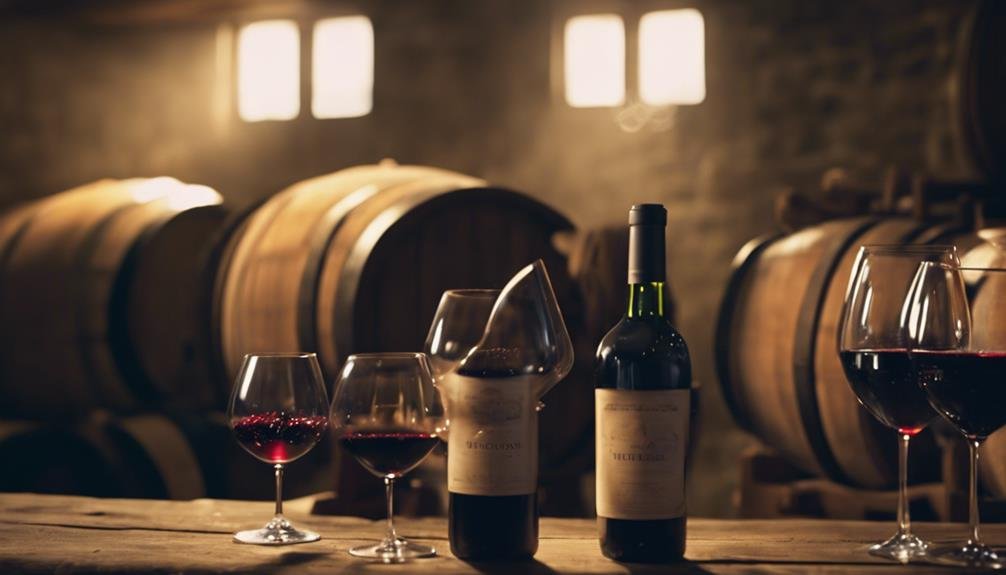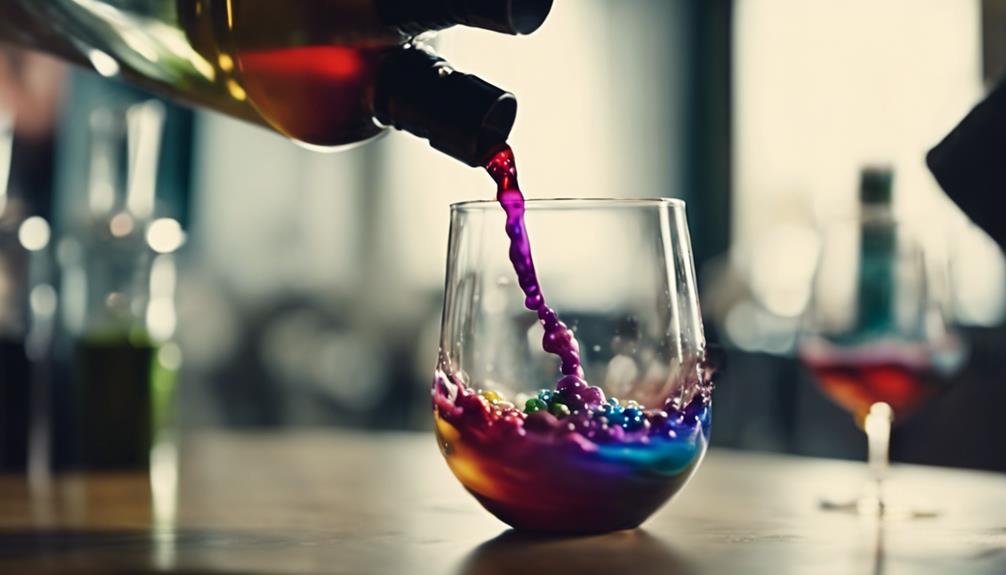The art of wine blending is a meticulous craft that involves harmonizing various grape varieties to create exquisite blends. Techniques vary, allowing winemakers to experiment and craft well-rounded flavors. Bordeaux blends, including Cabernet Sauvignon and Merlot, aim for a perfect balance reflecting tradition. Rhône blends, like Grenache and Syrah, showcase unique grape characteristics and desired harmony. Revealing unique blends offers insights into regional winemaking practices, highlighting hidden flavors and traditions. Mastering regional wine art explores the depth of grape varietals and terroir influences, shaping complex and diverse wines reflecting the essence of the land.
Wine Blending Techniques
When it comes to crafting exquisite wines, mastering the art of wine blending techniques is essential for achieving harmonious and complex flavor profiles.
Blending styles vary widely and can have a considerable impact on the taste of the final product. Winemakers experiment with different grape varieties, each contributing unique characteristics to the blend. Some blending styles focus on balancing fruitiness and acidity, while others aim for bold and robust flavors.
Understanding the flavor profiles of individual grape varieties is vital when creating blends that are well-rounded and enjoyable. By combining grapes in specific proportions, winemakers can create wines with depth, complexity, and a perfect balance of flavors.
This intricate process of blending is a fundamental aspect of winemaking that requires skill, experience, and a keen palate.
Secrets of Bordeaux Blends
Exploring the intricate harmony of grape varietals in Bordeaux blends reveals the artistry behind crafting these esteemed wines. Bordeaux blends are renowned for their complexity, balancing Cabernet Sauvignon, Merlot, Cabernet Franc, Malbec, and Petit Verdot to create rich and nuanced flavors.
Each grape contributes unique Bordeaux nuances, with Cabernet Sauvignon adding body and herbal notes, Merlot offering cherry flavors and refined tannins, Cabernet Franc providing savory red fruit characteristics, Malbec contributing rich black fruit flavors, and Petit Verdot intensifying color and structure.
Blending expertise is vital in achieving the perfect balance of these components, showcasing the winemaker's skill in creating a harmonious masterpiece that reflects the essence of Bordeaux's winemaking tradition.
Rhône Blend Mastery

Delving into the intricate art of Rhône blend mastery reveals the profound expertise required to harmonize Grenache, Syrah, and Mourvèdre into a symphony of flavors.
These Rhône varietals each bring unique characteristics to the blend, with Grenache complexity adding fruitiness, Syrah contributing bold flavors of black fruit and pepper, and Mourvèdre bringing savory notes of black fruit and game.
Among the three, Grenache stands out as the most important grape in the blend. The mastery lies in balancing these elements to create a wine that is greater than the sum of its parts.
Understanding the intricacies of each grape's contribution is key to achieving the desired harmony in Rhône blends.
Unraveling Unique Blends
Uncovering the intricacies of unique wine blends reveals the complexity and diversity present in regional winemaking practices around the world. Exploring innovative blends leads to revealing hidden flavors that showcase the artistry and skill of winemakers.
These unique blends offer a glimpse into the creativity and expertise required to craft exceptional wines that stand out in the industry. From Italy's Super Tuscan blend to Washington's CMS blend, each region brings forth a blend that reflects its terroir and winemaking traditions.
Mastering Regional Wine Art

To truly appreciate the depth and complexity of regional wine blends, one must understand the meticulous artistry involved in mastering the intricate nuances of grape varietals and terroir influences. Regional terroir, the combination of soil, climate, and topography unique to a specific area, plays an essential role in shaping the characteristics of grapes grown there.
Grape diversity further enhances the complexity of regional blends, with different varieties contributing their distinctive flavors and aromas. Winemakers carefully select grape varietals that thrive in the specific terroir of their region, ensuring that each blend reflects the essence of the land it comes from.
Frequently Asked Questions
Can Different Grape Varieties Be Blended After Fermentation?
Blending techniques in winemaking allow for the harmonious fusion of various grape varieties post-fermentation. This process enables winemakers to craft complex flavor profiles by combining wines stored separately, showcasing the artistry and skill involved in creating unique blends.
Why Do Some Grape Varieties Not Blend Well Together?
Certain grape varieties may not blend well due to grape compatibility issues. Factors like differing characteristics, tannin levels, acidity, and flavor profiles can impact the success of blending techniques. Understanding these nuances is essential for creating harmonious wine blends.
Are There Any Restrictions on the Number of Grapes Used in a Blend?
When crafting wine blends, winemakers often have the flexibility to choose from a range of grape varieties. While there are no strict restrictions on the number of grapes used, maintaining careful grape ratios and employing precise blending techniques are essential for achieving desired flavor profiles.
How Long Does It Take to Become Proficient in Wine Blending?
Becoming proficient in wine blending requires years of dedicated practice. Developing a deep understanding of tasting experiences, enhancing education levels, mastering blending techniques, and refining winemaking skills are essential to becoming a skilled and knowledgeable wine blender.
What Role Does Tradition Play in Creating New Wine Blends?
In the world of wine blending, tradition serves as a guiding force, shaping new blends. Exploring innovative techniques while retaining respect for established practices allows winemakers to infuse modern twists on blending traditions, creating unique and enchanting wine profiles.
Conclusion
In the enigmatic world of wine blending, techniques and traditions intertwine to create masterful concoctions like Bordeaux blends and Rhône compositions. Regional specialties like Super Tuscans and Rapsani offer a glimpse into the diverse and complex flavors that define each unique blend.
The art of wine blending is a meticulous craft that showcases the skill and creativity of winemakers worldwide, resulting in a symphony of flavors that captivates the senses. Join us on this journey to unravel the mystery of the art of wine blending.
